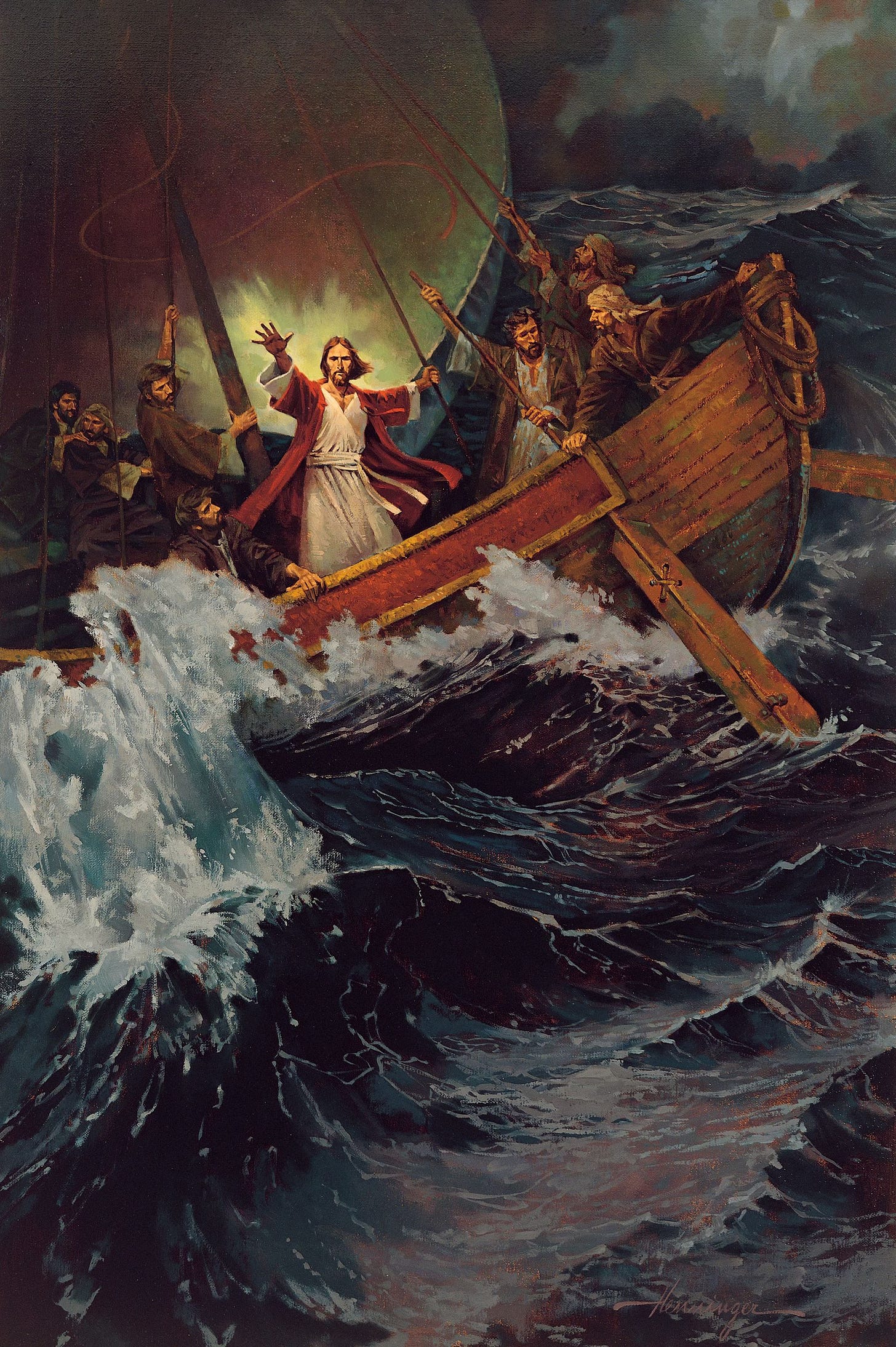Stilling the Storm
Latter-day Saint Visual Theology Series
The degree to which I still identify with Mormonism and Mormon theology has become increasingly fraught in the past decade. But the visual arts sometimes pull me back, not only as reminders of the faith tradition I once loved but also as expressions of the complications within that tradition that I still find evocative and compelling—even from a post-religious point of view. For example, I still find myself moved every time I re-encounter “Stilling the Storm,” by Ted Henninger.
Sure, “Stilling the Storm” fits into the Church’s correlative visual orthodoxy pretty cleanly; it’s not an especially radical or surprising piece, and scholars have rightly listed Henninger alongside other stylistically conservative artists who seem to reflect the LDS institution’s “ideals” regarding depictions of Christ.1 But “Stilling the Storm” still stands out to me, not in spite of its orthodoxy but perhaps because of it—or rather because of the tensions it embodies within that ‘approved’ orthodox space that it occupies.
In part this is because I’m intrigued by any stylistic breakaway from the stoic, calm, and unmoving aesthetics traditionally seen in depictions of Jesus. In this piece, I like to contemplate the way he stands vertical—contrasting the diagonals all around him—but still with a sense of angularity in his posture (his arms, outstretched, taut, strained, almost violent; his hair, wild; his robes, flowing). He's at once both a pillar of strength and a tumultuous, energetic, active god.
He is also seen from a distance; he’s the brightly illuminated focal point, to be sure, but spatially he only takes up a small portion of the painting.2 Above him, the sky is forbiddingly grey; below him, the entire bottom half of the frame is filled with the dark, frothy water of the Sea of Galilee. In film and photography we would call this kind of composition a “wide shot,” i.e., the entire (typically human) subject is visible in the frame, rather than a close-up of a face or a partial figure (think of the ‘medium shot’ seen in Del Parson’s famous red-robed portrait of Christ). This is to say that Henninger’s Jesus can only be understood in relation to his context. The storm, in its daunting enormity, suggests grandeur and commands our respect (perhaps even our reverence!) almost as much as does the Son. The storm is more than an obstacle—indeed there can be no miracle without it. So, in a sense, the storm co-creates with Jesus the majesty of the scene playing out here. Perhaps this is how all redemptive processes must work—as collaborative, coalitional enterprises intimately tied to the material reality surrounding us. Or, in philosopher Adam Miller’s words, “everything borrows from everything else.”
All of this communicates to me the idea that salvation, if it exists, can and must be a rough, tumbling process, full of yearning and stretching. Ultimately, if we are found pristine, immaculate, and quiet at the (proverbial or literal) ‘last day,’ then we have not forged any messy alliances, we have not fought any battles, and we will not have won anything of eternal merit.
We must dig our hands into the elements of the immanent to ascend to the transcendent. We must shed blood, sweat, and tears. We must awaken from our slumber, take hold of the fishing boat with one hand, and command the storm with the other. Only then will it pass.
Chris (@therealchriswei) is a Film Studies PhD candidate at the University of Iowa, working on a dissertation about digital resurrection. His writing has been published by BCC Press, Utah Historical Quarterly, and Ampersand: An American Studies Journal.
Art by Ted Henninger.
John G. Turner, The Mormon Jesus: A Biography (Cambridge, Mass.: Belknap Press of Harvard University Press, 2016), 267-8; as cited by Noel A. Carmack, “Correlating Orthodoxy and Style: Institutionally ‘Approved’ Christ-Centered Art in LDS Visual Resources and Meetinghouses, 1990-2021,” Dialogue 56:4 (Winter 2023), 39.
I know using a distanced point of view is not a radically new approach to depicting this particular story. There’s a similar sense of scope, dwarfing the boat in its stormy surroundings, in the composition used by Simon de Vlieger in 1637—or earlier by Rembrandt in 1632, or for that matter even earlier by Jan Brueghel the Elder in 1596. I have chosen Henninger’s depiction instead, because there’s something about his work that feels more essentially ‘Mormon.’ Admittedly, this association might have more to do with institutional correlative strategies, as noted earlier (and surely the emphasis on Jesus’ role in the story plays a pointed public-facing rhetorical role in the context of LDS image-making), but there’s still something aesthetically and perhaps theologically distinct happening in Henninger’s painting. A profound collision, perhaps—between a carefully curated sense of poise and the ragged intensity of the crisis at hand.




